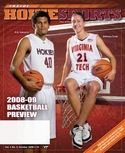The month of November marks the time for Thanksgiving, but for head coaches in most collegiate sports, the month marks the time for bringing in some top-notch talent.
The second week of November marks the early-signing period for all sports except field hockey, soccer, track and field, cross country and men’s water polo. These sports have signing periods strictly in the spring.
During this week, which starts Nov. 12th and runs through Nov. 19th, prospective student-athletes sign national letters-of-intent [NLI] with respective schools. Most knowledgeable fans know the definition of a letter-of-intent – a binding agreement between the prospect and the school in which the prospect agrees to attend the school for one academic year (not one playing season!) and the school provides financial aid for a year – but few know about the other intricacies involved with the letter.
So here’s an opportunity to get your fill on the NLI. These are some commonly asked questions fielded by the Virginia Tech compliance office.
- How is the NLI handled?
The CCA (Collegiate Commissioners Association) – not the NCAA – administers the NLI program. Once a prospect receives a letter from a school, it must be signed within 14 days from the date of issuance. The prospect signs two copies, keeping one and returning the other to the school. If he or she is under 21, then he or she needs to get a parent or legal guardian to sign it as well.
The institution then sends the letter to the conference office within 21 days. The conference determines the validity of the letter and then enters the student-athlete into the NLI database.
- Can the NLI be declared null and void?
Yes, if the signee is denied admission to school or does not meet NCAA eligibility requirements. Other ways for an NLI to be declared null and void include if the signee doesn’t enroll for a year and a scholarship is no longer available; if the signee serves in the military or goes on a church mission for a year; if the signee’s sport is discontinued; and if there are recruiting violations.
- What happens if the student-athlete changes his/her mind and wants to attend another school?
The basic penalty is he or she sits out a year in residence at the new school and loses a season of eligibility.
- What if there is a coaching change?
The prospect signs the NLI with the school, not with a coach. If the coach leaves, the prospect is still bound by the provisions of the NLI.
- Can a signee be released from an NLI?
Yes, an institution may release a student-athlete from all penalties. If the school denies the release, then the signee may appeal to the NLI Policy and Review Committee. A decision by that committee may be appealed to the NLI Appeals Committee, whose decision is final and binding.
Fan Question of the Month
Q: How many contests can a student-athlete participate in and still receive a ‘medical hardship waiver’?
A: The medical hardship waiver (often referred to as a ‘medical redshirt’) is a complex and often misunderstood part of Division I college athletics. To receive a medical hardship waiver, a student-athlete may not have participated in more than 30 percent of the team’s contests. Additionally, the injury or illness must occur prior to the completion of the first half of the season.
If the percentage calculation for the 30-percent rule results in a decimal – any decimal – the number is always rounded up. For example, the lacrosse team competed on 17 dates. Thirty percent of 17 is 5.1. A student-athlete who competed on six of the first eight dates does qualify for a medical hardship waiver.
To meet the first-half-of-the-season requirement, all competition must have ended prior to the start of the contest or date that begins the second half of the season. For example, any competition in the 10th game of a 19-game season would prevent a soccer player from receiving a medical hardship waiver.
The key to receiving a medical hardship waiver is that the injury or illness must leave the student-athlete unable to compete for the remainder of the season. Substantial documentation must be provided to confirm the debilitating nature of the injury or illness.




